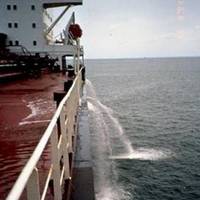All Ships’ Ballast Water Checked in Great Lakes Seaway
The Great Lakes Ballast Water Working Group (BWWG) released its 2015 Summary of Great Lakes Seaway Ballast Water Management activities Thursday. During 2015, 100 percent of vessels bound for the Great Lakes Seaway from outside the Exclusive Economic Zone received a ballast water management exam. In total, the BWWG assessed all 8,361 ballast tanks on the 455 vessels that transited during the 2015 navigation season. The Great Lakes Seaway Ballast Water Working Group is a binational collection of representatives from the U.S. Coast Guard, the U.S. Saint Lawrence Seaway Development Corporation, Transport Canada - Marine Safety & Security and the Canadian St. Lawrence Seaway Management Corporation.
Bound for the Great Lakes? Ballast Tank Exam a Certainty

The Great Lakes Seaway Ballast Water Working Group (BWWG) informs of the release of its 2013 Summary of Great Lakes Seaway ballast water management report. The mission of the BWWG is to harmonize ballast water management efforts between: the U. S. Coast Guard, Transport Canada – Marine Safety and Security, the Saint Lawrence Seaway Development Corporation, and the St. Lawrence Seaway Management Corporation. Since 2006, ballast water management requirements in the Great Lakes and the St. Lawrence Seaway System have been the most stringent in the world.
Great Lakes Ballast Water Report Published
The Great Lakes Seaway Ballast Water Working Group announces the release of the 2013 Summary of Great Lakes Seaway ballast water management report. The mission of the BWWG is to harmonize ballast water management efforts between: the U. S. Coast Guard, Transport Canada – Marine Safety and Security, the Saint Lawrence Seaway Development Corporation, and the St. Lawrence Seaway Management Corporation. Since 2006, ballast water management requirements in the Great Lakes and the St. Lawrence Seaway System have been the most stringent in the world. As a result, independent research by Fisheries and Oceans Canada (Science) has indicated that the risk of new aquatic invasive species being introduced into the Great Lakes via ballast water has been mitigated to extremely low levels.
Ballast Water Inspections Improve, GL/Seaway
A new U.S. government report released March 13 showed a notable increase in the number of ballast tank inspections of oceangoing commercial ships entering the Great Lakes St. Lawrence Seaway System from outside U.S. or Canadian waters. Ship operators also improved their compliance with ballast water requirements in 2008 compared with 2007, the report says. The 2008 Summary of Great Lakes Seaway Ballast Water Working Group released by the U.S. Coast Guard examined the U.S.-Canada Great Lakes Seaway System ballast water ship inspection program. The report finds that 99 percent of all oceangoing ships bound for the Great Lakes Seaway System ports from outside U.S. or Canadian waters in 2008 received a ballast tank exam, compared with 74 percent in 2007.





